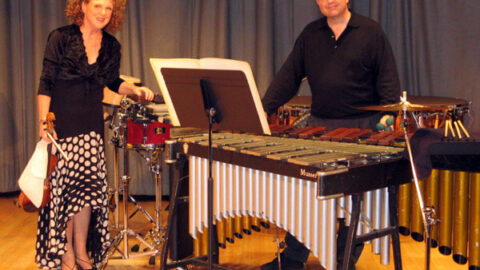 “Isotone: A Collision of Music and Physics” (Symphony Space, Leonard Nimoy Thalia, October 24th) certainly lived up to its name. Featuring two percussionists, two vocalists, violin, and piano (though not all together on all pieces), Isotone captured the excitement, energy, and humor, as well as the dangers, of physics. This concert was the NYC premiere of the program; violinist-and-percussionist couple Susan and Scott Eddlemon have taken the Isotone program all over the country. The other performers were Larry Spivack on percussion, Pam Roberston on piano, and vocalists Christina Mullikin and Sara Reed.
“Isotone: A Collision of Music and Physics” (Symphony Space, Leonard Nimoy Thalia, October 24th) certainly lived up to its name. Featuring two percussionists, two vocalists, violin, and piano (though not all together on all pieces), Isotone captured the excitement, energy, and humor, as well as the dangers, of physics. This concert was the NYC premiere of the program; violinist-and-percussionist couple Susan and Scott Eddlemon have taken the Isotone program all over the country. The other performers were Larry Spivack on percussion, Pam Roberston on piano, and vocalists Christina Mullikin and Sara Reed.
The stage setup was immediately impressive simply due to the incredible variety of percussion instruments packed onto it. Furthermore, despite a hardy job of drum-Tetris on the part of the stage crew and musicians, not every piece of equipment would fit at once, and there were several lengthy equipment changes as various large resonant objects were carted on and off. All of the intricate-looking paraphernalia evoked a laboratory, and in fact different pieces utilized both a spectroscope and a Van De Graaff Generator.

The first piece was Victoria Bond’s A New Light, scored for both percussionists, violin, and piano. It consisted of two movements, Inner Light and Stable and Unstable Elements, and was dedicated to Marie Curie. The first movement centered on a single melodic fragment, first presented as a sweet and soft violin melody. This central idea was transformed and fragmented over and over again, with the piece gradually growing more frantic. In the end, the energy level came back down, and the piece concluded with soft violin harmonics. In contrast, the second movement, true to its title, was much more forceful and dissonant throughout. Although the violin was featured as a soloist several times, this movement’s most impressive moment was a virtuosic percussion solo requiring Scott to play many different drums in the span of a few seconds. The energetic final bars, merging the sounds of piano, percussion, and violin into a single cohesive whole, left a feeling of palpable, unresolved tension hanging in the air.
Scott Eddlemon himself wrote the second piece, Improvisations on Three Isotopic Spectra. The piece was dedicated to his physicist father (who was in the audience), Joe Eddlemon. Scott turned his childhood fascination with his father’s spectroscopic expertise into a multimedia piece. The visible spectra formed by, in succession, cobalt, sodium, and uranium were project onto a screen. Scott and the second percussionist, Larry Spivak, performed structured improvisations informed by the changing wave images on the screen.

Number one, Cobalt-60: metal, was surprisingly calm, ethereal, and meditative throughout; successive gong hits at two pitches symbolized the two different wave peaks visible at certain times on the cobalt spectrum. The second part, Sodium: wood, had a steady rhythm on log drum from Larry, while Scott made creative use of the wooden, non-head portions of toms and bass drum before moving onto the woodblocks. The steadiness of the log rhythm provided an anchor of stability against the shifting improvisations on the blocks. Finally, on Uranium: skins, Larry again had more of a steady role, essentially keeping time on timpani, while Scott performed impressive, sweeping hits of every skin, gradually growing in volume and speed as the waveform on the screen continued to increase in amplitude. Finally, at the end, an unexpected and “illegal” gong hit took the audience by surprise.
Mark Harrell’s Dialogue For Violin and Percussion was dedicated to Albert Einstein, perhaps the most famous and instantly recognizable figure in all of physics; also, perhaps not coincidentally, a student of the violin. The work featured both percussionists in addition to the violin, making it in some ways more of a trialogue: although the percussion instruments, primarily xylophone and vibraphone, often played in unison, in some sections of the piece the two players were given very separate identities, like a single idea or formula that spawns many new experiments and discoveries. The most prominent melodies, however, appropriately enough were assigned to the violin.

Although billed as a twelve-tone work, most of Dialogue sounded more like a Romantic character piece than a Schoenberg étude. Although highly chromatic, the work unfolded in such direct and straightforward ways that it was easy to get caught up in the emotions rather than the tonal language, leaving the impression of an atonal melody resting on a foundation of traditional harmonies. Einstein, by the end of his life, was known for his political and philosophical views, such as his opposition to the development of the atomic bomb, as much as for his scientific prowess. He was also tormented by his inability to resolve certain seeming contradictions in contemporary physics. So, despite moments of excitement and forward motion, the piece ended as it began, with a rather somber violin solo, evoking the solitary genius, the man who defined 20th century physics but was never quite comfortable with his own creations.
The following group of pieces, Physics Song Cyclotron, attempted comic relief, but were mostly awkward, simplistic, and trite. Fortunately, the last work, Larry Spivack’s three-movement Space, a truly effective programmatic piece inspired by Stephen Hawking’s book for children, George’s Secret Key to the Universe, rescued the concert. Susan Eddlemon broke out the electric violin for this one, and its haunting, sometimes distortion-driven strains were a welcome contrast from the more traditional uses of the instrument earlier in the concert.
Floating was appropriately mysterious and vague, but driven nevertheless by the interactions of the two percussionists. Asteroid Storm was bombastic, essentially a shouting match between the bass drum and the timpani. It was not unmusical however—the two instruments played contrasting, competing rhythms, giving the impression of an asteroid field filled with rocks of different sizes flying every which way at once. Finally came A Black Hole, the audience participation piece (plastic-and-metal “clickers” were distributed during intermission), which grew from a repetitive, subtly shifting base to a staccato crescendo that suddenly disappeared entirely, just as the lights were killed. Then, the crackling lights of the Van De Graaff generator, and the visual cue to click, first every few seconds, then constantly. An abrupt stop, the lights back up, and the journey past the event horizon was over.
—
Matt Weber is a New York based composer, educator, and political slacktivist.
























